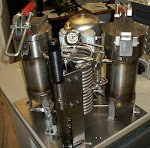 Early production stage hydrogen generation company AlumiFuel Power, Inc. (“API”), the Philadelphia, Pennsylvania-based wholly owned operating subsidiary of AlumiFuel Power Corporation (OTCBB: AFPW), (the “Company”), announced today that it is Positioned to aggressively move into the commercialization stage in early 2010, as one product is now entering the marketplace and another product is ready for market entry.
Early production stage hydrogen generation company AlumiFuel Power, Inc. (“API”), the Philadelphia, Pennsylvania-based wholly owned operating subsidiary of AlumiFuel Power Corporation (OTCBB: AFPW), (the “Company”), announced today that it is Positioned to aggressively move into the commercialization stage in early 2010, as one product is now entering the marketplace and another product is ready for market entry.The PBIS-1000 hydrogen generator is now in production, and delivery of these operational units to customers is expected to begin shortly. (See API news release of December 30, 2009). This unit uses two 32oz.cartridges filled with API’s proprietary AlumiFuel powder mix to generate 1,000 liters of hydrogen as lift gas to launch a five-foot weather balloon in 20 minutes. The PBIS-1000 is a unique product, not available from any other source in the world; it enables cost-effective balloon launching from any remote or inaccessible location without having to rely on expensive electrolysis or steam reforming technologies, or on hard-to-handle and logistically difficult K-Cylinders. In fact, 10 of the 32oz cartridges generate 5,000 liters of hydrogen – the same as a K-Cylinder, and at far lower pressures.
The weather balloon market is pegged at $150-$200 million per year, and encompasses military as well as civil government meteorological users worldwide. API and its partner, Kaymont Consolidated of Long Island, NY – the world’s largest distributor of weather balloons – have demonstrated pre-production versions of the PBIS-1000 to customers, and the production unit reflects considerable customer feedback. Based on customer reaction, Kaymont and API expect to begin capturing significant market share in 2010, and believe the PBIS-1000 can become the field standard and product of choice. After purchasing PBIS-1000 hydrogen generators, customers will continue to purchase replacement cartridges sufficient for each generator to launch 500-1,000 balloons each year (1,000-2,000 cartridges). This is analogous to the razor/razor blade market dynamic.
Of equal importance to the weather balloon market, the PBIS-1000 can easily be tailored to feed fuel cells to generate electricity for back-up, stand-by, auxiliary and portable power. API is in discussions with several major fuel cell companies regarding specific applications. Small, portable fuel cell applications potentially represent an $8 billion annual market as fuel cells replace older technologies such as gensets and batteries. It should be noted that hydrogen provides 4-5 times the energy density (and hence operating time) of lithium batteries.
API has also completed development of a new generation of flameless heaters – which can heat rations, or fuel personal warmers. (See API news release of December 21, 2009). The most highly visible application in this genre is the Flamelss Ration Heaters (FRH) which heats MREs (Meals-Ready-to Eat) in about 20 minutes. The US Department of Defense (DoD) spends about $36 million annually on these heaters for MREs. Worldwide, this FRH market is about $70 million for military and commercial applications. The incumbent FRH provider to the DoD operates on a sole source basis using a magnesium powder-based mix. After considerable comparative testing in API’s laboratory, it is apparent that API’s AlumiFuel powder-based mix is superior in terms of heat generated per gram and time of heating, and is significantly cheaper. API now has a product ready for this market and is in a dialogue with the cognizant DoD offices to determine the appropriate path for market entry. API also is exploring various options for path-to-market partners to address the larger global market.
In addition to these market-ready applications, API and a major aerospace partner are continuing to pursue a longer-range, but highly important mission-critical undersea application for the U.S. Navy. Together with a major subsidiary of the world’s second largest aerospace & defense company (a Fortune-50 firm), API is in discussions with U.S. Navy R&D activities regarding appropriate programs to develop a prototype Unmanned Underwater Vehicle (UUV) propulsion system using API’s AlumiFuel-water reaction as the source of superheated steam to drive the aerospace firm’s turbines. Again, application of these combined technologies would be unique, and would replace very costly lithium-based batteries while providing 4-5 times the mission duration. The two companies are optimistic that this effort will lead to a new-start R&D program in 2010; of course, once such a new propulsion system is ready for the marketplace, actual system procurement would likely be measured in the billions of dollars.
API’s President and Chief Executive Officer, Mr. David Cade, said, “It is very gratifying to note that with our strong engineering development focus, we are at the forefront of commercializing this aluminum-water hydrogen generating technology, which in many instances is still a laboratory curiosity. We have successfully harnessed this technology for on-site, on-demand, real world hydrogen applications, embodied in real products for real customers. I am extremely proud of our superb technical team which has made this happen, and we are now looking forward to an unbroken string of successes in our target markets.”




No comments:
Post a Comment